Related Research Articles

Publius Licinius Egnatius Gallienus was Roman emperor with his father Valerian from 253 to 260 and alone from 260 to 268. He ruled during the Crisis of the Third Century that nearly caused the collapse of the empire. He won numerous military victories against usurpers and Germanic tribes, but was unable to prevent the secession of important provinces. His 15-year reign was the longest in half a century.

The Gallic Empire or the Gallic Roman Empire are names used in modern historiography for a breakaway part of the Roman Empire that functioned de facto as a separate state from 260 to 274. It originated during the Crisis of the Third Century, when a series of Roman military leaders and aristocrats declared themselves emperors and took control of Gaul and adjacent provinces without attempting to conquer Italy or otherwise seize the central Roman administrative apparatus.

Marcus Cassianius Latinius Postumus was a Roman commander of Batavian origin, who ruled as emperor of the splinter state of the Roman Empire known to modern historians as the Gallic Empire. The Roman army in Gaul threw off its allegiance to Gallienus around the year 260, and Postumus assumed the title and powers of Emperor in the provinces of Gaul, Germania, Britannia, and Hispania. He ruled for the better part of ten years before he was murdered by his own troops.

The antoninianus or pre-reform radiate was a coin used during the Roman Empire thought to have been valued at 2 denarii. It was initially silver, but was slowly debased to bronze with a minimal silver content. The coin was introduced by Caracalla in early 215 AD. It was silver, similar to the denarius, except that it was slightly larger and featured the emperor wearing a radiate crown, indicating it was a double denomination. Antoniniani depicting women featured the bust resting upon a crescent moon.
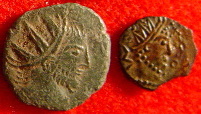
Barbarous radiates are imitations of the antoninianus, a type of coin issued during the Roman Empire, which are so named due to their crude style and prominent radiant crown worn by the emperor.
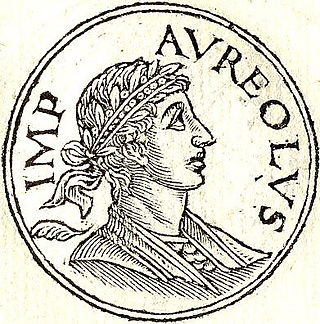
Aureolus was a Roman military commander during the reign of Emperor Gallienus before he attempted to usurp the Roman Empire. After turning against Gallienus, Aureolus was killed during the political turmoil that surrounded the Emperor's assassination in a conspiracy orchestrated by his senior officers. Aureolus is known as one of the Thirty Tyrants and is referenced in ancient sources including the Historia Augusta, Zonaras' epitome and Zosimus' Historia Nova.

The Hoxne Hoard is the largest hoard of late Roman silver and gold discovered in Britain, and the largest collection of gold and silver coins of the fourth and fifth centuries found anywhere within the former Roman Empire. It was found by Eric Lawes, a metal detectorist in the village of Hoxne in Suffolk, England in 1992. The hoard consists of 14,865 Roman gold, silver, and bronze coins and approximately 200 items of silver tableware and gold jewellery. The objects are now in the British Museum in London, where the most important pieces and a selection of the rest are on permanent display. In 1993, the Treasure Valuation Committee valued the hoard at £1.75 million.
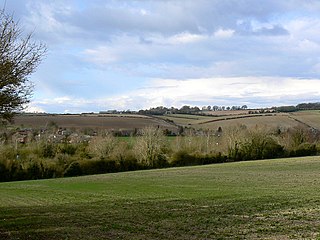
Cunetio was a large walled town in a valley of the River Kennet in modern-day Wiltshire, England. The settlement was occupied from the 2nd century CE by Romano-British people until the post-Roman period, and was abandoned in the early 5th century. Its site is near the village of Mildenhall, about 1+1⁄2 miles (2.4 km) east of the market town of Marlborough.

Littlecote Roman Villa is an extensive and exceptional Roman villa, with associated religious complex, at Littlecote Park just over a mile west of Hungerford, Berkshire. It has been excavated and is on display to the public in the grounds of the estate.
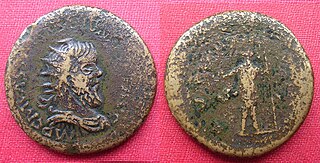
The double sestertius was a large Roman coin made of orichalcum (brass) first issued by Trajan Decius in AD 249–251, as a response to the inflationary pressures of the time which had devalued the buying power of the conventional sestertius. In reality the new coin was little bigger than the traditional sestertius, which by then was being manufactured at a lower weight and smaller size than it had originally been, and was not a success.
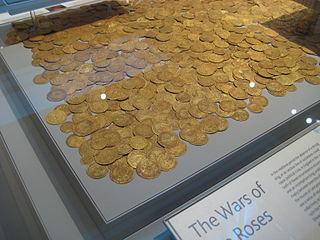
The British Museum Department of Coins and Medals is a department of the British Museum involving the collection, research and exhibition of numismatics, and comprising the largest library of numismatic artefacts in the United Kingdom, including almost one million coins, medals, tokens and other related objects. The collection spans the history of coinage from its origins in the 7th century BC to the present day, and is representative of both Eastern and Western numismatic traditions.

Komin is a village in Dubrovnik-Neretva County in Croatia on the river Neretva.
The Stanchester Hoard is a hoard of 1,166 Roman coins dating from the fourth to early fifth century found in 2000 at Wilcot, in the Vale of Pewsey, Wiltshire, England. The find was considered important because of the large quantity of unclipped silver coins contained within. It was also the latest dated example of Roman coins found in Wiltshire.

The Shapwick Hoard is a hoard of 9,262 Roman coins found at Shapwick, Somerset, England in September 1998. The coins dated from as early as 31–30 BC up until 224 AD. The hoard also notably contained two rare coins which had not been discovered in Britain before, and the largest number of silver denarii ever found in Britain.

The Snettisham Jeweller's Hoard is a collection of Romano-British jewellery and raw materials, found during the construction of a house in the Norfolk village of Snettisham in 1985. The hoard is thought to be the working stock of a jeweller, buried in a single clay pot around 155 AD. The finds include the working tip of a quartz burnishing tool, partially or fully completed items of jewellery, and raw materials: mainly silver coins, scrap silver items and silver ingots, but also six pieces of scrap gold, and many engraved gemstones to be set in rings. The presence of scrap gold and silver and absence of base metals indicates that the jeweller dealt mainly with high-status customers.

The Celtic currency of Britain were the various items and coins used as currency between approximately 200 BC and AD 60. The earliest currency consisted of various forms of iron bars. Coins were first imported in large numbers in around 150 BC and domestic minting began around 100BC. Coin production was largely ended by the Roman conquest of Britain, first by the Claudian invasion of AD 43 and later by the Defeat of Boudica in AD 60 or 61. Cast coins may have been produced for a few more years around Hengistbury Head. Exact dating of coins often changes in the light of new research.

Legionary denarii is the modern name for a series of Roman silver denarius coins issued by Mark Antony in the eastern Mediterranean during the last war of the Roman Republic from 32 to 31 BC, in the lead up to the Battle of Actium. The coinage is also referred to by numismatists as RRC 544/1-39, after its designation in M. H. Crawford, Roman Republican Coinage (1975).
The Shillington Hoard is a Roman coin hoard found in Shillington, Bedfordshire in 1998. It consisted of 127 gold aurei, the latest of which was from 79 AD. The coins were issued by Tiberius, Claudius, Nero, Galba, Otho, Vitellius, and Vespasian.
References
- ↑ Nigel Kerton, C4's Time Team dig in at Mildenhall, at gazetteandherald.co.uk, Friday 4 September 2009
- 1 2 Abdy 2002 , pp. 32–43
- ↑ British Museum Collection
- ↑ Nurse, Keith. "Late Roman Coin Hoards and Wansdyke". Wansdyke Project 21. Retrieved 3 September 2016.
- ↑ "The Archaeology of Wiltshire's Towns An Extensive Urban Survey Cunetio" (PDF). Wiltshire County Archaeology Service. Retrieved 3 September 2016.
- ↑ Moorhead, Sam; Kent, John (2010). "Cunetio (1960) hoard". Wiltshire Archaeological and Natural History Magazine . 103: 317–19.
- ↑ "Roman Hungerford". Hungerford Virtual Museum. Retrieved 3 September 2016.
- ↑ Abdy, Richard; Ghey, Eleanor; Hughes, Celine; Lewis, Ian. "Coins Hoards from Roman Britain Volume XII" (PDF). Collection Moneta. Retrieved 3 September 2016.
- ↑ Manders, Erika (2012). Coining Images of Power: Patterns in the Representation of Roman Emperors on Imperial Coinage, A.D. 193-284. BRILL. p. 54. ISBN 9789004224001.
- ↑ "Gallienus (August AD 253 - March AD 268)". Timeline Originals. Archived from the original on 20 September 2016. Retrieved 3 September 2016.
- ↑ "The Cunetio Treasure". Ancient Numismatic Enterprise. Retrieved 3 September 2016.
- ↑ "Postumus Antoniniani, Cologne mint, Complete List". Gallic Empire. Retrieved 3 September 2016.
- ↑ "Tesoro monetale di Misurata (Libya)" (in Italian). Consiglio Nazionale delle Ricerche. Archived from the original on 11 December 2009. Retrieved 25 June 2010.
- ↑ "Museum on Time Team this Sunday!". Wiltshire Museum. Retrieved 3 September 2016.